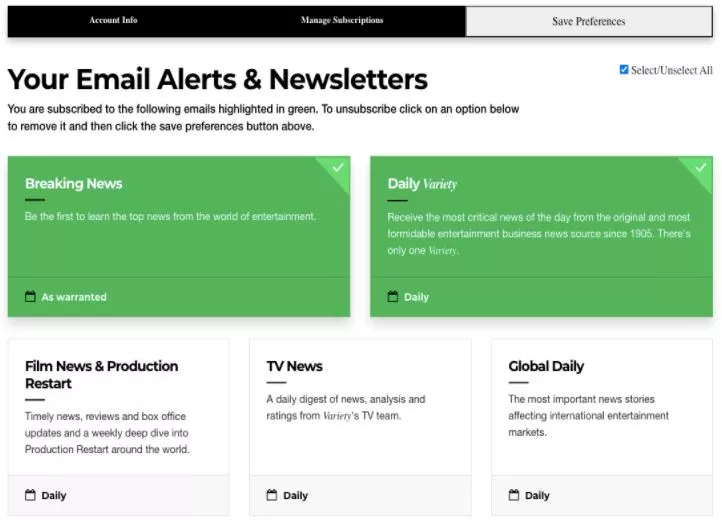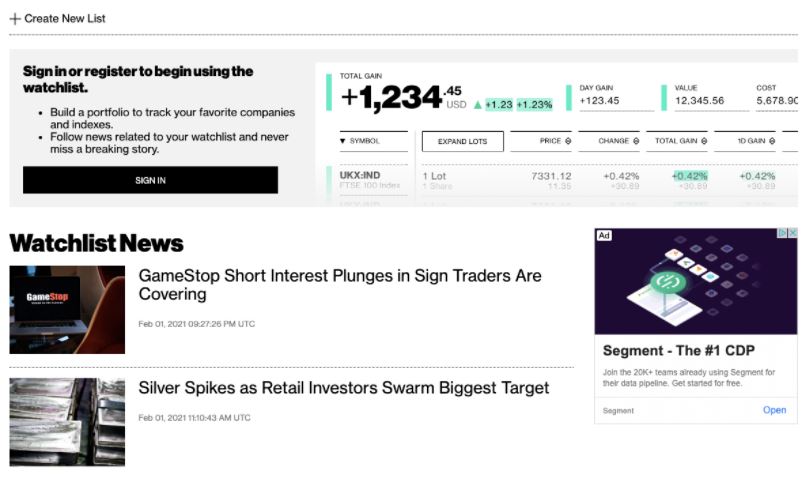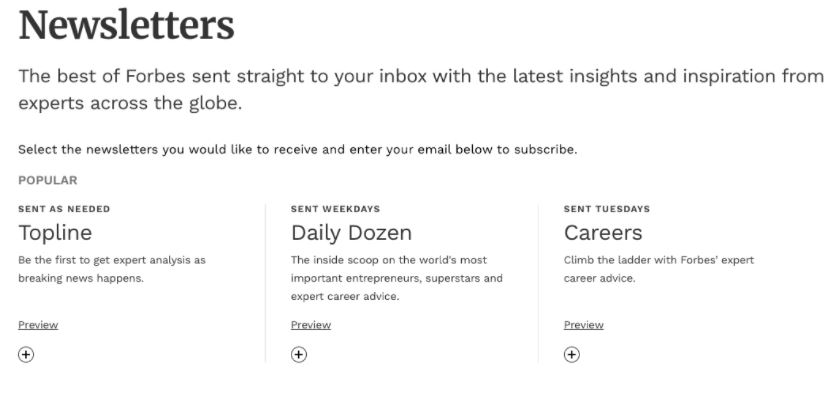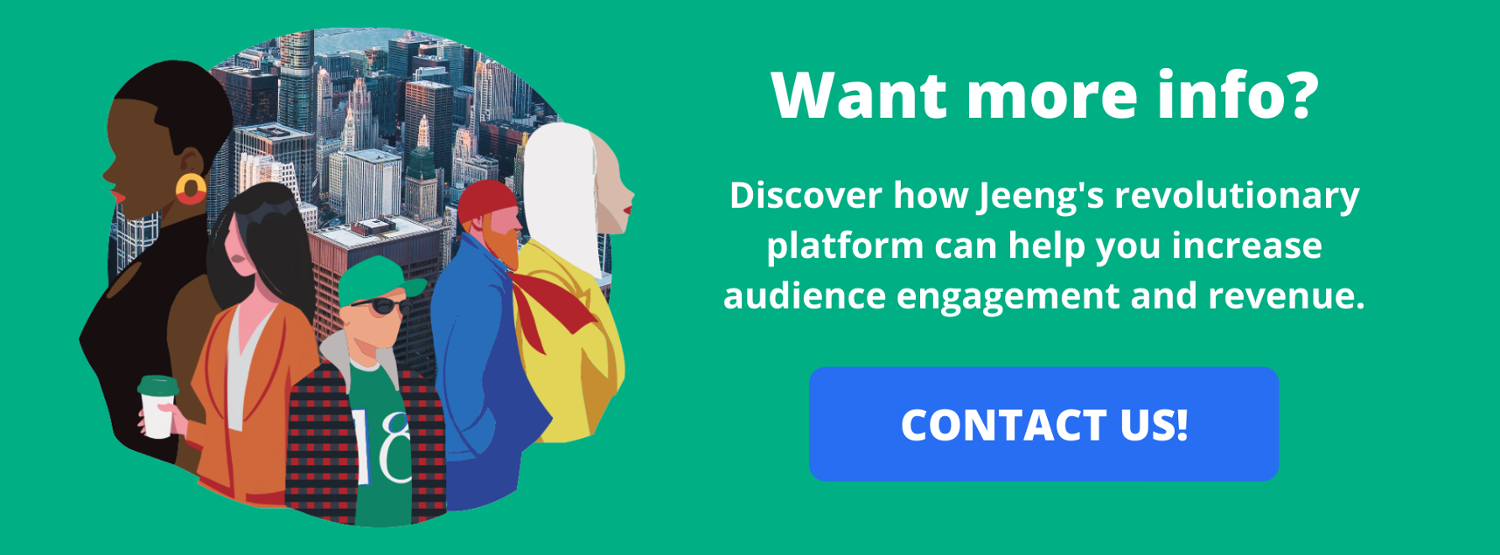Not all customers are alike.
Some want weekly emails, others want breaking news alerts. Some want daily roundups about sports, others want mobile notifications about politics.
You get it. Audiences can have a range of interests and behaviors, and it’s the publisher’s job to make sure they can choose content based on those unique desires.
That’s where the preference center comes in — it’s the part of your website or mobile app that helps each user build their own experiences and select exactly what they want to see.
Here’s what you need to know about what preference centers are, why they’re so important, and how you can start customizing your own.
What is a preference center?
A preference center is a web page that invites users to select which messages they want to receive and when they want to receive them. A tech publication, for example, might provide options for email newsletters about business tech, consumer tech, product reviews, and new gear launches. Or a fashion publication might launch push notifications with beauty tips, shopping guides, and celebrity news stories.
Take Variety, which provides a selection of daily and weekly email newsletters for people to choose from, with options for receiving everything from breaking news alerts and podcasts to videos and virtual events:

Like Variety, most publishers don’t actually call this page the “preference center.” Instead, they might call it “My alerts” or “Subscription preferences.”
Bloomberg, for instance, has a page called “Watchlist,” which subscribers can use to track news stories about stocks in their portfolio and consume general watchlist news stories about the stock market.

Why are preference centers so important?
Preference centers are important because they give your audience control over how they experience your content.
More specifically, here are some benefits of preference centers:
- Increase subscriptions. Publishers are investing in subscription models to make up for lost ad revenue and to nurture direct, long-term relationships with their audiences. They can help drive those subscriptions by providing a la carte content options for readers, allowing them to essentially build their own subscription packages that meet their needs.
- Deliver personalized experiences. Personalization is crucial in order to gain and retain customer attention across the web, where people have a wealth of channels and content types to choose from. According to Accenture, 83% of consumers are willing to share information in exchange for personalized experiences. And, as Instapage reported, 74% of consumers feel frustrated when website content isn’t personalized to their interests.
Check out what our CEO, Jeff Kupietzky has to say about the importance of content personalization:
- Gather first-party data. Preference centers can save you a lot of time combing through third-party data and trying to decipher exactly what people want from your publication. That’s because, with a web page dedicated to customer preferences, you can gather owned, first-party data directly from your users and gain a clear idea of which topics and content types people prefer. First-party data is also key to surviving the imminent death of the third-party cookie, when publishers will be on their own to track and target their audiences.
- Build unique audience segments. With access to this owned data, you can then build more accurate audience segments for content and ad campaigns. For example, you can turn to your tech ad partner and say, “Hey, I run this newsletter specifically for people interested in tech news and products.” You can then monetize that newsletter by running ads from the tech company, driving revenue and customer engagement as a result.
How can you customize your preference center?
Begin building your preference center by taking stock of your email newsletters and content verticals. For example, you might offer the following email newsletters:
- Daily breaking news stories
- Daily politics updates
- Weekly trending news roundups
- Weekly coronavirus updates
Forbes, for instance, offers a range of newsletters covering different topics and sent at different frequencies:

You might also offer push notifications to alert users about:
- Just-published stories in tech, fashion, or global news
- Trending stories that are quickly gaining traffic
- Updates on breaking news stories as they unfold
Once you have these options laid out, simply decide how you want to present them in your preference center. Then let your audience do the rest — choosing their preferences and providing you with valuable data about their favorite types of content.
Give your audience what they want
A publication without a preference center is like a restaurant without a menu. Sure, you might provide a lot of delicious options, but how are customers supposed to actually know what those options are — and more importantly, communicate what they want so you know how to deliver?
Especially if you’re using a multichannel approach — delivering content via email, push notifications, and news reader apps — you’ll need a central place where people can select their favorite channels.
At Jeeng, we’re all about that multichannel messaging, because we know people don’t just use one platform to consume their favorite content. They check their email, browse the web, read on mobile apps, and visit their go-to websites to get the information they crave. And we help you use these channels to reach them with targeted, personalized campaigns fueled by first-party data.
Ready to get started and give your audience the content they want on their preferred channel and desired time? Contact us today to learn more.




